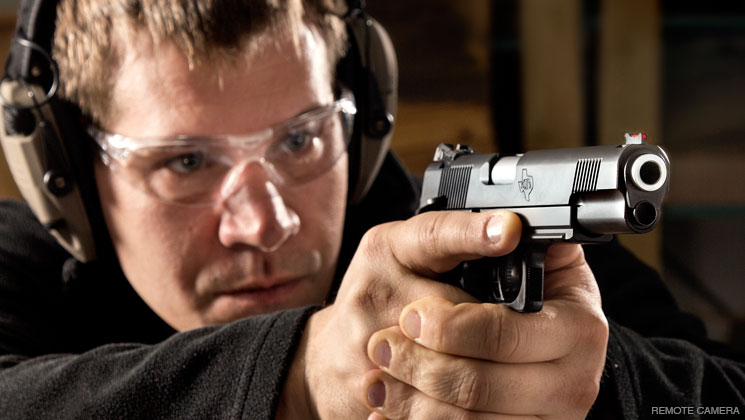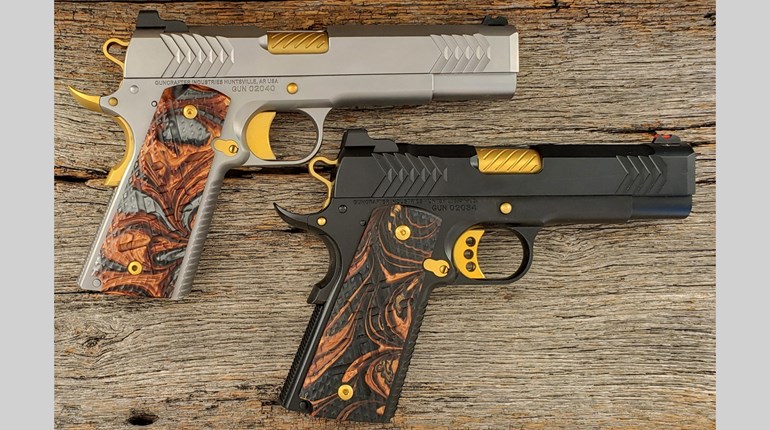
In the rough-and-tumble world of 3-gun competition, a lot of handguns are left broken and weeping by the roadside. Just as in life, there are no “alibi runs” in action shooting and if your gun fails, you lose. Therefore, any gun must keep up and keep working, or it’s dumped and forgotten.
Want to know what the winners run for handguns? Simple. Most of them shoot an STI 2011. Sure, all brands are represented in the sport, but unless there is a sponsorship involved, the top shooters usually run an STI—even some sponsored shooters often find a way to run an STI.

A few years ago, I shot several matches with one of the high-profile sponsored teams from a company that made handguns. This team even included some executives from the company, yet they ran STI guns. They concocted some story about how their company was thinking about a joint venture with STI to sell a competition gun, but it never materialized. Let’s face it, they just liked winning.
What is a 2011? Think of it as a 1911 with a wide-body and a double-stack magazine. It has all the great features of the 1911—like a smooth, single-action trigger—but it holds a lot more ammo.

No question, STI guns are expensive. You can buy a half dozen polymer-frame, striker-fired competition handguns for the price of one new, top-of-the-line, STI DVC Open pistol and still have money left over. Even the STI entry-level model is about three times as expensive as your average polymer-frame handgun. It comes down to this question: Do you want the best tool for the job, be it competition or personal defense? Or do you want to shop based purely on price? Like most other things in life, you get what you pay for.
Of course, the glass-half-full way of looking at things is that you can get into a new STI 2011 handgun for about what you would spend to attend a major match. The Eagle 2011 is the company’s most-popular pistol for 3-gun, and it has an MSRP of $1,899. Street price is probably a couple of hundred less. With airfare, hotel, rental car, food, entry fees and ammo, that’s the price of one major match. When you look at it that way, it’s a bargain! OK, maybe that’s a stretch, and you will probably need to add a few modifications to the Eagle to make it competition-ready. Alternatively you can buy STI’s new 2011 model handgun designed for
3-gun shooting.

“The Eagle was our most popular gun with 3-gun shooters,” STI’s Director of Marketing and Sales, Jens Krogh, told me. “So we took a look at the most common modifications and requests for that gun and used them to build a handgun designed for 3-gun competition. We called it the Marauder.” Krogh added that, “the Eagle does not have a rail, but we kept hearing that with more nighttime matches most shooters want the option of mounting a light and laser. Of course all our guns are designed for tactical use as well, and many serious defensive shooters wanted the ability to mount a light or laser. So we put a rail on the Marauder. We also added a Dawson fiber-optic front sight and a fully adjustable TAS rear sight.”

STI received feedback that 3-gun shooters want a light and reactive handgun. While other action-shooting sports favor higher barrel weight to deal with the recoil of major cartridges, most 3-gun shooters use the lower-recoiling 9 mm, and they prefer a lighter firearm. Not only is the Marauder faster for target-to-target transitions, with all the gear a competitor is carrying for a full day, every ounce helps fight the fatigue factor. The Marauder is built with a lightweight top end with a barrel bushing, which keeps the weight down to 41 ounces empty.
One big factor for a lot of us is the grip size on a double-stack handgun. I have wide hands with stubby Irish fingers, and I have trouble reaching the trigger properly on a lot of wide-body handguns. The STI guns typically have some of the smallest grip frames in their class. This means we digitally challenged folks can shoot them with proper trigger-finger placement. The company’s 1911s also have a wonderful two-stage, single-action trigger, which is a huge factor in precision shooting with a handgun. I think these two factors alone account for much of the STI handgun’s success.

The Marauder has an ambidextrous safety, and its magazine release is prominent enough to work well, but not get in the way of lefty shooters, or during those weak-hand-only stages. It has a 5-inch barrel and a full-length guide rod. The slide assembly is pretty much a 1911 design with an internal extractor. It’s a flattop design with front and rear cocking serrations. The frame is all STI, though—it’s steel with a separate, polymer grip frame. This keeps weight down and helps with the balance of the handgun. The polymer trigger is curved and serrated. It can be swapped out for a shorter trigger for those with smaller hands.
The handgun has an oversize, tactical, flared magazine well for fast reloads, but it remains legal for USPSA and IDPA and will fit in their dimension boxes. The magazine well has scalloped finger-cuts for easy gripping if a mag sticks. It’s been my experience after using multiple STI handguns that they rarely stick. In fact, never would be the proper adverb in my time with STI pistols, but you never know when you might encounter extreme conditions like mud, ice, snow or dust that could cause a mag to stick. Think of this as a redundant system for the most unlikely circumstance. Little things like that will help win a match, or keep you alive in a fight.

While the Marauder was designed for competition, many of the features serious 3-gun shooters look for are important to a defensive handgun, too. Reliability, accuracy, durability, magazine capacity and high-visibility sights—all of these attributes are important in a fighting gun. The Marauder is an outstanding choice for a defensive handgun as well a competition pistol. In fact, I know of at least one elite-forces, bearded, badass type who carries a Marauder as his personal defensive handgun.
The single metal magazine shipped with the gun holds 20 rounds for a 20+1 capacity. Magazines are available from STI in 10-, 17-, 20- and 26-round capacities.

The gun uses the STI Sear-X trigger, which provides an excellent trigger pull. The pistol I received for testing measured at about 4 pounds, 2 ounces, which is just a bit heavy for my taste, but it’s so slick and smooth it feels much lighter. Of course, it’s easily modified by a competent gunsmith to a much lighter pull.

Both the slide and the frame are coated with a black Cerakote finish. This tough finish can hold up to the brutality of 3-gun or continued exposure to sweat and the elements from everyday carry.
I am a lefty, so it was a bit harder to find a holster than it is for the commoners. But my buddy Tim Wegner at Blade-Tech hooked me up with an OWB Kydex model configured for the proper hand. I used the Marauder during the 2015 shooting season in a bunch of 3-gun and USPSA matches. Of course, I had to shoot minor in USPSA with the 9 mm chambering, but if you shoot well it doesn’t matter, right? You only are scored minor for the marginal hits. I can assure you that I owned all misses and penalties free and clear—they were my fault, not the gun’s. I lean more to 3-gun and for that, this pistol is hard to improve upon. I’ll go out on a limb and say that it is the ultimate, out-of-the-box 3-gun pistol. Just add ammo, and you’re good to go.
STI has made some limited runs of Marauders in .40 S&W for USPSA shooters, and Krogh tells me the company may add the cartridge to the Marauder line if demand is there. Not only will that solve the “minor-cartridge” issue for USPSA shooters, those buying the gun for tactical, defensive use will have a more-powerful option than the 9 mm.

I wanted the Marauder for competition, and there the 9 mm is king. For serious defensive use, I prefer the STI Tactical in .45 ACP. It’s my concept of the ideal fighting handgun. By shooting the Marauder for competition, though, I gain familiarity with the STI design and feel, so when I carry and shoot the Tactical, it all feels familiar.

So, how did the Marauder perform? Let me preface this by saying that I have a custom handgun built on an STI frame. I figured I would shoot the Marauder at a few matches for this article and then go back to my custom handgun. But I fell in love with the Marauder. I have taken it to every match I have shot since the holster arrived. Other than taking a little weight off the trigger pull, I wouldn’t change a thing. Even at that, I was surprised when I put a scale on the trigger for this article. It’s so smooth and predictable that prior to measuring I “guessed” it at 3 pounds and planned to leave it alone. Sometimes knowledge is not a great thing.
I have about 1,000 rounds through the gun with a mix of handloads and factory ammunition. I can’t recall a single time it malfunctioned—zero jams or function failures. In doing the accuracy testing from the shooting bench, the gun ejects all the empty cases in a pile at my 4 o’clock, which is just about perfect.
This is a serious handgun for serious shooters. I don’t think you can beat it as a competition gun at this price point. If you prefer to carry a full-size pistol, it gives you all the features of a 1911 that gun guys love, but with more than twice the magazine capacity. Where is the downside in any of that?






































